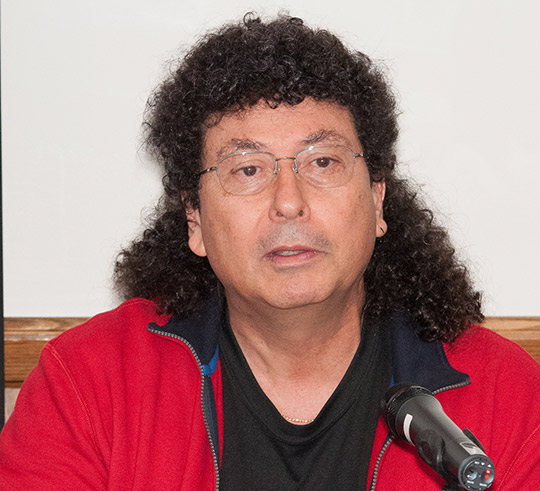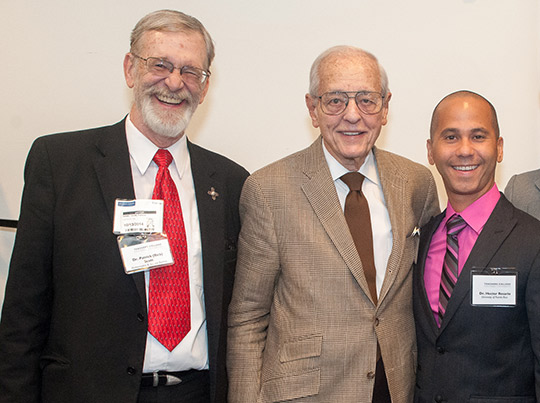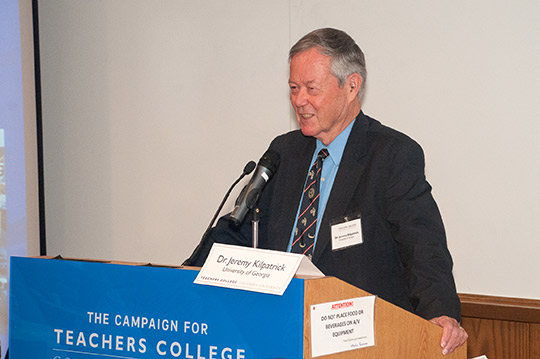Sign of the Times: Symposium highlights Latin America's growing mathematics prowess
Leadership in mathematics education may still be dominated by the United States and Europe, but math researchers, teachers and students in Latin America and the Caribbean are asserting themselves on the global stage. The region is now home to a wealth of journals and organizations for mathematics researchers and educators, and has seen an explosion of virtual communities and information sharing along with a revitalization of math education programs. In 2014, symbolizing this wholesale transformation, 35-year-old Artur Avila of Brazil became Latin America’s first recipient of the prestigious Fields medal for his work in the area of chaos theory.
Such was the backdrop for the Symposium on Math Education in Latin America, which brought the region’s leading lights in the field to TC on Columbus Day. The event, chaired by Bruce Vogeli, Clifford Brewster Upton Professor of Mathematical Education, was TC’s second annual international mathematics education symposium. It also marked the publication of Mathematics and Its Teaching in the Southern Americas, an anthology edited by Vogeli, Héctor Rosario (Ph.D. ’03), and Patrick Scott (Ed.D. ’80) that examines the progress the region has made over the past five decades.
“I felt that there was something to be said by my colleagues in Latin America concerning their successes,” said Vogeli. “This gives them a voice of their own.”
Many of the work’s contributors—from Argentina, Bolivia, Brazil, Chile, Colombia, Costa Rica, Cuba, Guyana, Haiti, Honduras, México, Panamá, Paraguay, Perú, Puerto Rico, Trinidad and Tobago, and Venezuela—presented at the symposium alongside TC faculty members Alexander Karp and Henry O. Pollak (honoree at the 2013 symposium).
“Where you have different cultures you have different views of mathematics,” said Brazil’s Ubiratan D’Ambrosio, a pioneer in the field of ethnomathematics who spoke via Skype hook-up to receive TC’s 2014 International Mathematics Education Achievement Award. His views were echoed by Eliana D. Rojas of the Neag School of Education at the University of Connecticut, who contributed to the anthology her study of Chilean programs, and whose current focus is Latin American students who have immigrated to the United States. “The population of Latino students in the U.S. is growing,” said Rojas, who has been federal funded since 2011 to train a cohort of education professionals to work more successfully with Connecticut’s ELLs (English language learners) in Connecticut, which has the largest math achievement gap in the nation. “In 2011 they were 9.1 percent of the student population. By 2015, one out of five students will be an ELL. We need greater context assessment and evaluation in order to build bridges between Latin American students and their teachers in this country.”
Vogeli believes that understanding the prior math preparation of immigrant students from Latin America can provide important opportunities to foster their inclusion and success in U.S. classrooms. “There are different recipes for long division in different countries,” he says. “If a Guatemalan student demonstrates her method of long division to a U.S. class, it can be a source of learning and cultural pride.”
Others highlighted the benefits of cultural diversity for mathematical thinking in general. In Guatemala, said Claudia María Lara Galo, current President of the Latin-American Committee for Mathematics Education (CLAME), “there are 24 official languages; many of which are Mayan. So there are 24 different ways of solving problems! We Guatemalan educators are creative and flexible; our diversity is an asset, not a problem.”
The region’s political shifts are perhaps the single most significant variable affecting the landscape of math education in Latin America, the participants agreed, with the power to engender, maintain or destroy programs. “When government changes, school initiatives change,” said Vogeli. “Autocratic governments see schools as tools to power. Educated and gifted children are thinking children, and thinking children often become leaders in dissent.”
Vogeli, who has traveled the world to study math education, has experienced the consequences of political change firsthand. In 1982, during an invited speech in Chile, he jokingly made a reference to the Pinochet regime’s takeover of universities, and was taken into custody by the Chilean secret police. It took a call from the U.S. Ambassador to secure his release, and he was subsequently expelled from the country.
In contrast, stability breeds success. Costa Rica, one of the most politically stable societies in the region, is widely viewed as a mathematics leader. It recently unveiled a new mathematics curriculum for primary and secondary schools, the development of which was led by symposium presenter Ángel Ruíz, President of the Inter-American Committee of Mathematics Education (IACME) and Vice President of the International Commission on Mathematical Instruction (ICMI), an organization founded in 1908 by the late mathematician and TC professor David Eugene Smith. The basis for the Costa Rican curricula is a pedagogical strategy called “Problem Solving with Emphasis in Real Contexts,” which proposes lessons organized around building learning through carefully selected problems. It is reinforced through curricular emphasis on promoting positive attitudes and beliefs about mathematics, an intense use of digital technologies and the use of the history of mathematics.
“Collaboration by ‘crossing borders’ is essential to making Latin America more of a player on the international stage,” said former TC faculty member Jeremy Kilpatrick, currently of the University of Georgia. He cited a 2013 workshop in math problem solving, which brought 25 speakers from 15 countries to the University of Chile/Santiago, as a model. The conference was based on work accomplished in a three-year common project of Chile’s CONICYT (National Commission for Scientific and Technical Research) and Finland’s AKA (Academy of Finland).
As the symposium looked toward the future, D’Ambrosio emphasized the global and humanitarian implications of excellence in math education: “We must give good mathematics for the next generation, to create noble hearts and minds. At a time when our natural resources—especially water—are being extinguished, we need to teach students how to put mathematics in service to mankind. We must use our science toward acts of good, to foster respect for one another and for our culture.” —Nanette Maxim
Published Friday, Oct. 24, 2014


